Repair Topics
Leaking Hot Water Heater Pipes
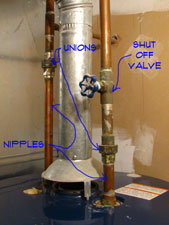 A leaking hot water heater can result from leaks in the pipes. At the top of your hot water heater you have an inlet and an outlet pipe. The cold water comes in and hot water goes out. There is usually an union on each one that allows for the removal of the hot water tank.
A leaking hot water heater can result from leaks in the pipes. At the top of your hot water heater you have an inlet and an outlet pipe. The cold water comes in and hot water goes out. There is usually an union on each one that allows for the removal of the hot water tank.
Not sure if this is your problem? See the articles 'Troubleshooting Gas Hot Water Heaters' and 'Electric Water Heater Troubleshooting' for a listing of all of the water heater problems and solution resources.
Condensation
Just because you see water droplets on the pipes or the top of the water heater does not necessarily mean you have a leak. It could be condensation. Cold water lines will sweat during hot humid conditions. At times this water may run down the pipe and puddle up on the top of the tank.
Before you assume that you have a leak, dry off the pipes and try to determine where the water is coming from. If the only water is coming from condensation on the pipe, then you don't have a leak.
For gas hot water heaters there may be another type of condensation if your vent is not operating correctly. If you are getting a back draft from your vent, it can cause some condenstion and staining on the top of the tank. See the article on 'Venting Gas Water Heaters' for instructions on what to do.
Types of Leaks
When we are talking about the piping for water heaters we are generally talking about water lines. Although on a gas water heater you will also have a gas line. Gas lines have fittings to and can leak, but that is a different subject.
The only other pipe on a water heater that can leak is the drain valve. For a discussion on how to stop the drain valve from leaking, see the article, 'Repairing Water Heater Drain Valves'.
Water Pipe Fittings
For leaks that occur at the unions you will need to tighten them. Use two pipe wrenches to do this. You put the pipe wrenches on in opposing directions. It will take a little muscle to tighten them.
The other place that the pipes might leak is at the nipple where the pipes enter the tank. Are the connections old and corroded? This could be a problem. The tank may have started to rust. Messing with this connection could render the tank unusable. Their is not much you can do if you damage the threads going into the tank. Do they seem OK, just leaking a little?
You can try tightening them. Shut the water off on the cold water inlet. Open a valve in a sink near by to drain down the water in the pipes. You will need to loosen the unions above the nipples. With the union loose you can tighten the nipple with the pipe wrench. It will take some force, but be careful.
Don't go much more than a quarter to a half a turn. Still leaking? Nuts! Go the other way and take the nipple out. Clean up the threads and put new pipe dope or Teflon tape on them. Put the nipple back in and tighten it up. Tighten the union and turn the water back on. This should take care of a leaking hot water heater, when the nipple is leaking.
Water Line Valves
You should have a valve on the cold water inlet side of the tank. Valves have washers in them and can start to leak around the valve stem. See the article 'Fixing Leaking Valves' for instructions on how to fix this problem.
Summary
If you do have a leak, tightening the fittings should solve the problem. It may be that you have some condenstaion, lowering the humidity in the area where the water heater is will solve this problem.
Leaking Pressure Relief Valve
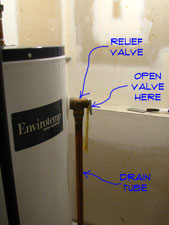 A leaking pressure relief valve usually means getting a new valve. There is little that can be fixed on them, once they go bad.
A leaking pressure relief valve usually means getting a new valve. There is little that can be fixed on them, once they go bad.
Before you decide that your pressure relief valve is leaking, you want to check the valve and make sure that it is bad. See the aticle "Checking a Presssure and Temperature Valve' for instructions on what to do.
If you are sure that your valve is leaking, there is not much you can do to fix it. See the article 'Replacing a Water Heater Pressure Relief Valve' to find out what you need to do.
Your leaking hot water heater may be from the pressure relief valve. The pressure relief valve is on the side of you hot water tank near the top. It may have a copper tube attached to it. This tube channels the hot water down to the floor.
When the pressure inside your hot water tank builds up to the danger level the pressure relief valve releases the pressure. This is safety feature that is built into every tank. When the valves go bad they start to vent when the pressure is not at the danger level. This can be just dripping to a full blown spray.
There is not an adjustment on a pressure relief valve. You will need to replace it if it is venting and leaking water.
Leaking Water Heater Drain Valve
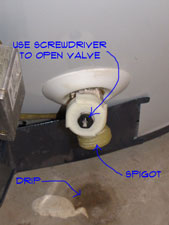 A leaking water heater drain valve may be easy or not so easy to fix. The age and quality of your tank are both factors.
A leaking water heater drain valve may be easy or not so easy to fix. The age and quality of your tank are both factors.
You have a three options with the leaking valve, one would be to try and tighten the fittings on the valve, see 'Tightenting a Water Heater Drain Valve'. Second would be to put a cap on the spigot, this only works if the leak is small. See 'Capping a Water Heater Drain Valve'. Third, you can replace the valve, this is a bigger job. See 'Replacing a Water Heater Drain Valve' for more information.
For a list of all the water heater topics, see 'Troubleshooting Gas Water Heaters' and 'Electric Water Heater Troubleshooting'.
Near the bottom of your hot water tank you will find the drain valve. From the factory your hot water tank comes with a plastic valve. These valves are not high quality and sometimes they start leaking when you use them. How serious this is depends on how bad it is leaking and where it is leaking.
The first thing to do is open the valve a little and then shut it back off and tighten it. This will release any sediment that may have caught in it. Did this fix your leaking hot water heater? Yes, great, you're done.
Where is the water coming from. Is it coming from the spigot? Is it minimal? You could take the easy way out and put a cap on it. A couple of bucks at the hardware store.
Is the spigot leaking a lot? Or is it leaking where it connects to the tank? Yes to either of these means you should replace the valve. Go to the article 'Replacing a Water Heater Drain Valve' for information on changing the valve.
WARNING!! Be CAREFUL the Water in Your Hot Water Tank is VERY HOT!!! WARNING!!!
Leaking Hot Water Heater
 A leaking hot water heater, is this bad news or what? It could be, on the other hand it may not be that serious. What do you have a 40, 50 or even a 60 gallon hot water tank? That's a lot of water.
A leaking hot water heater, is this bad news or what? It could be, on the other hand it may not be that serious. What do you have a 40, 50 or even a 60 gallon hot water tank? That's a lot of water.
Your water heater has water lines entering and exiting. Fittings can leak and the tank itself can leak. There are several possible sources for leaks on a hot water tank. There is information below that will help to track down the issue.
Do you have another problem with your water heater? See the article 'Electric Water Heater Troubleshooting' and 'Troubleshooting Gas Hot Water Heater Problems' for a listing of all the issues that can come up with a water heater. The articles will point you to resources to solve the problem.
Not All Drips Are Leaks
Several years ago I installed a new hot water tank in my home. I was thoroughly proud of myself when I fired it up. It was a big job, it went fairly well and I was quite confident that it was a success. After a few minutes I noticed water dripping onto the floor. I checked all of the fittings, no leaks. What could it be?
I was devastated, it appeared to be coming from the tank. A brand new hot water tank and I managed to get a defective one. I found a phone number in the manual, good deal, I was going to do some venting. This was the early eighties and technology was not what it is today. I got an automated response system with a not convincing computer generated voice. After several minutes and a plethora of questions I got my answer. Condensation, the tank was filled with cold water and now it was heating up. By the next morning there was not any sign of water dripping.
Leaking Hot Water Heater - Information
What Can You Save?
Not sure how to answer this. Tightening a fitting could be a $100 experience. Finding out that your tank is leaking and you need a new one, well that is going to cost a lot more. Let's hope your problem is simple and you are going to realize it is nothing or be able to fix it within a half an hour. Go with the $100 figure. Great pay if you can do it in a half an hour.
How Hard Could It Be?
Fixing a leaking hot water heater by tightening something is not that hard. Finding out it is just condensation is even easier. Replacing a hot water tank is hard and not the subject of this article.
Check the Simple Things!
Condensation is the easiest thing. Is the tank filled with cold water? Then it is condensation. Tightening the drain valve is also pretty easy.
What Can Go Wrong?
Old corroded fittings can be difficult to work with. You may think you will just tighten something up and bang, you break it. When the tank is leaking you are living on borrowed time. Forty gallons on hot water on your floor can make a big mess and damage other things. Being without hot water will irritate the family, especially if it lasts any length of time.
Troubleshooting a Leaking Hot Water Heater
The water heater drain valve is a common culprit for water heater leaks. The article 'Leaking Water Heater Drain Valve' will give you some tips on what to do with it.
Another item that is prone to leaking is the pressure relief valve. They are designed to open when a dangerous pressure is reached. An older valve may open before the pressure is high enough. You can review the article 'Leaking Pressure Relief Valve' by following this link.
You have cold water pipes leading into and hot water pipes leading out of your hot water tank. It could be that some of these are leaking. See the article 'Leaking Water Heater Pipes' for more information.
Condensation is not a leak at all, although it might appear to be. When there is a lot of cold water in the tank, condensation can occur. The article 'Water Heater Condensation' tells you when this can occur and what to watch for.
The worst leak of all is that tank itself. Water heater tanks are glass lined and made of cast metal material. They cannot be repaired when they crack. Replacing it may have be your only option. To review this subject, see 'Leaking Water Heater Tanks'.
Summary
Were you able to take care of your leaking hot water heater? I hope it was something simple. Changing a drain valve or a pressure relief valve is a little work. Tightening the fittings can also be a little tough.
Or did you find out it was something really easy like condensation. Nothing to do at all. I'm afraid to ask, was the news bad? Is your hot water tank terminal? Is the tank leaking? Are you sure it is not condensation? This is not good news. Replacing it means a big expense and a lot of work. Sorry.
Objects Stuck in Disposal
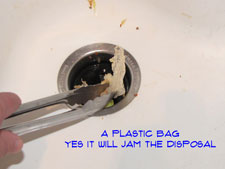 Removing objects stuck in a disposal will need to be done even after you get it freed up. Disposals will not grind up certain things, so removing them is the best course.
Removing objects stuck in a disposal will need to be done even after you get it freed up. Disposals will not grind up certain things, so removing them is the best course.
Coins and rings are a couple of things that can jam a garbage disposal. They get wedged between the turntable and the side of the housing and can be difficult to dislodge. Try to locate the object if you can.
I know, you were probably trying to use it when the jam occurred. Try to remove the water and food and see if you can identify the object. Use pliers, a screwdriver or tongs to get it free. No fingers, please.
Once the object is free, use the tongs to extract it. Go back to the allen wrench and make sure the jammed garbage disposal is moving freely now.
When it is moving freely, you can remove the wrench and turn the power back on. Check to see that the disposal is working correctly. It's grinding and the water is going down? Wonderful this jammed garbage disposal will soon be a forgotten memory.
Prying the Disposal
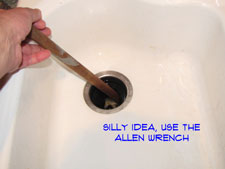
Prying a jammed disposal with a broom handle or another similar object is not a good idea. See the article 'Using a Garbage Disposal Wrench' for the best method on freeing up a jam.
I'm not sure whether using a broom handle to free a jammed garbage disposal is a last resort or creative thinking. If you don't have an allen wrench and it is too late to go out, it is creative thinking. If all else has failed then it is a last resort. I do not believe that a broom handle will generate much more force than the allen wrench and a pair of pliers would. If it makes you feel better, try it.
At this point, you may be faced with a tough decision. Assuming you cant' free up the motor and you cannot find an object that can be removed, you may be faced with replacing your disposal.
Try one more time with the allen wrench to worry it loose. Still stuck? I feel your pain. A new disposal will run between $75 and $200. The difference is for power, features and whatever else they use to get you to spend more. It will take an hour or so to replace.


